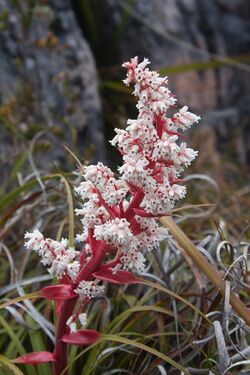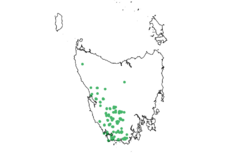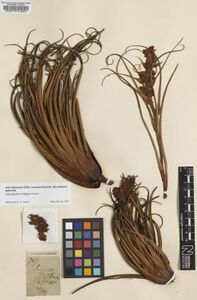Biology:Dracophyllum milliganii
| Dracophyllum milliganii | |
|---|---|

| |
| Dracophyllum milliganii, Mount Eliza, Southwest National Park | |
| Scientific classification | |
| Kingdom: | Plantae |
| Clade: | Tracheophytes |
| Clade: | Angiosperms |
| Clade: | Eudicots |
| Clade: | Asterids |
| Order: | Ericales |
| Family: | Ericaceae |
| Genus: | Dracophyllum |
| Species: | D. milliganii
|
| Binomial name | |
| Dracophyllum milliganii Hook.f.[1]
| |

| |
| Natural range | |
Dracophyllum milliganii is a species of angiosperm in the family Ericaceae and the sub-family Epacridoideae. It is a distinctive alpine shrub, endemic to western Tasmania.
Description
Dracophyllum milliganii is grouped into two populations with significantly different appearances and habitats. In alpine and sub-alpine heathland it forms a graminoid shrub about 5 to 20 cm high with 20 cm curling leaves. In alpine rainforests and wet sclerophyll forests, it forms a small tree or erect shrub with stems up to 4 metres and leaves 1 to 1.5 metres long, with a similar habit to Richea pandanifolia.[2] Its leaves have serrulate margins (very finely toothed) and are dark green and grey brown when dead. The leaves are sheathing at the base and highly crowded. The inflorescence is a terminal flower spike with a thick red stem and small white to pink flowers fused into tubes. The leaves of D. milliganii are similar to Richea pandanifolia which forms a large erect tree in rainforests but has small flowers arising from the axis of the stem and highly serrate (toothed) leaf margins.[3]
Sample collected by Joseph Dalton Hooker
Habitat and distribution
D. milliganii is endemic to western and south-western Tasmania.[3] Found in alpine areas above 850 metres altitude, but can survive lower altitudes in its rainforest form.[2] It is found in harsh, open alpine sites on peaty or well-drained rocky soils in areas of regular snow lie. Along with Isophysis tasmanica its presence is useful in determining communities of Tasmanian highland treeless vegetation, as it appears in western alpine heathland (HHW) and cushion moorlands (HCM).[4]
Taxonomy
The first formal European description of D. milliganii was by botanist Joseph Dalton Hooker in his book Flora Tasmaniae (1860)[5] based on plant material collected at Mount Sorrell by Joseph Milligan,[1] a surgeon and amateur naturalist who attended an expedition to Macquarie Harbour in 1842. J.D Hooker named this and many other species after Milligan, calling him, "'one of the most indefatigable and able of Tasmanian botanists."[6] J. D. Hooker named the genus Dracophyllum after the genus Dracaena or "dragon tree" for their superficially similar foliage.[5][3]
Phylogeny
Dracophyllum species are distributed around Australasia with large amounts of species in New Zealand and New Caledonia. The genus is closely related to Richea and Sphenotoma and the relationships between D. milliganii and the other genera are still unclear.[7] There are two species of Dracophyllum in Tasmania, Dracophyllum minimum is a species of cushion plant and highly specialised for high wind areas.[2]
References
- ↑ 1.0 1.1 "Dracophyllum milliganii ". Australian Plant Name Index (APNI), IBIS database. Centre for Plant Biodiversity Research, Australian Government, Canberra. http://www.anbg.gov.au/cgi-bin/apni?TAXON_NAME=Dracophyllum+milliganii.
- ↑ 2.0 2.1 2.2 "Dracophyllum milliganii ". Key to Tasmanian Vascular Plants. University of Tasmania. http://www.utas.edu.au/dicotkey/dicotkey/EPACRIDS/gDracophyllum.htm.
- ↑ 3.0 3.1 3.2 "Dracophyllum milliganii". Australian Native Plants Society (2018). http://anpsa.org.au/d-mil.html.
- ↑ "The Vegetation Communities: Highland treeless vegetation (2017)". From Forest to Fjaeldmark, edition 2. Department of Primary Industries, Parks, Water and Environment. https://dpipwe.tas.gov.au/Documents/f2f_highland_treeless.pdf.
- ↑ 5.0 5.1 Hooker, J. D., Flora Tasmaniae, Volume 2 (1860), Lords Commissioners of the Admiralty, London. Available at:https://play.google.com/books/reader?id=mhMWAAAAYAAJ&hl=en&pg=GBS.PA158
- ↑ Hoddinott W. G.. "Milligan, Joseph (1807-1884)". Australian Dictionary of Biography, 1967. https://adb.anu.edu.au/biography/milligan-joseph-2456.
- ↑ Venter, S."A taxonomic revision of the Australasian genera Dracophyllum and Richea (Richeeae: Styphelioideae: Ericaceae)" (2021) Australian Systematic Botany,34. doi:10.1071/SB19049
Wikidata ☰ Q5304668 entry
 |




